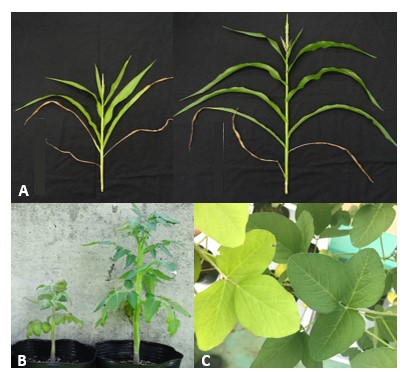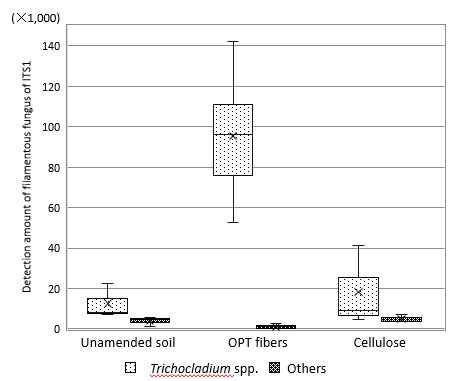Effect of conventionally decomposed oil palm trunks on the soil environment
Description
Oil palm fruit is harvested 3 years after planting until the harvest yield declines at around 25 years, and oil palms need to be replanted at an interval of 25–30 years to maintain oil productivity. Oil palm trunks (OPTs) are logged for replantation and the fiber residues are disposed of into the palm plantation area. The fiber residues are expected to increase soil fertility through recycling of carbon and minerals via fiber decomposition. However, the unregulated disposal of OPT can have detrimental effects on soil functioning and plant growth. To understand the effect of OPT fiber on the soil environment, this study compared corn, tomato, and bean plant growth and nutrient availability in soil mixed with OPT fiber and other comparable soil amendments using cellulose powder.
(A) soil+OPT fiber (1:20), (B) soil+cellulose powder (1:20), and (C) unamended soil as a negative control plot were prepared and tested. The effect of amendment with OPT fiber on plant growth was compared in a pot experiment. In the period after 25 days after sowing, the low chlorophyll contents were consistent with the symptoms of nutritional disorders such as yellowish leaves and stunting of height. Furthermore, OPT fiber treatments caused a reduction in heights and SPAD values (chlorophyll content), with a maximum reduction of 54.9% of the height and 58.8% of SPAD compared with plants grown in the control soil. The dry weight of biomass was reduced by 53.3% for the OPT fiber treatment when compared with the control (Fig. 1). The plants grown with OPT fiber were deficient in total nitrogen and magnesium when compared with those without fiber amendment, which suggested that nitrogen and minerals in the soil might be taken up by the changing microflora because of the OPT fibers’ presence (Table 1). To confirm the differences in the soil microflora, metagenomics analysis was performed on untreated soil and soil from each lignocellulose treatment. The microflora of soils mixed with OPT fiber and cellulose revealed substantial increases in bacteria such as families Cytophagaceae and Oscillospiraceae, and two major fungal genera, Trichoderma and Trichocladium, that are involved in lignocellulose degradation. OPT fiber resulted in a drastic increase in the ratios and amounts of Trichocladium in the soil when compared with those of cellulose treatments (Fig. 2).
These results indicate that unregulated disposal of OPT fiber into plantation areas could result in nutrient loss from soil by increasing the abundance of microorganisms involved in lignocellulose decomposition. To protect palm plantation productivity, co-composting of these biomass products or re-using OPT for other products is necessary.
Figure, table
-
Table 1. Plant analysis results of plants grown in unamended soil and soil supplemented with oil plant trunk (OPT) fiber
-
Fig. 1. Growth trend of plants
A: corn, B: tomato, C: beans. Left: soil mixed with OPT fiber (OPT fiber), right: soil not mixed with OPT fiber (unamended soil). -
Fig. 2. Microbial relative abundance of sequences from unamended soil, OPT fibers, and cellulose
The ITS region sequence amount of Trichocladium spp. and other filamentous fungi generated by metagenome is shown. As a control, the soil mixed with cellulose (manufactured by Sigma-Aldrich) is shown.Figures and table reprinted/modified from Uke et al. (2021) with permission.
- Classification
-
Research
- Program name
- Research Project
-
JST/JICA・SATREPS
- Term of research
-
FY 2019–2021
- Responsible researcher
-
Uke Ayaka ( Biological Resources and Post-harvest Division )
ORCID ID0000-0001-5077-8353Kosugi Akihiko ( Biological Resources and Post-harvest Division )
Chuah Jo-Ann ( Universiti Sains Malaysia )
Sudesh Kumar ( Universiti Sains Malaysia )
Abidin Nur Zuhaili Harris Abidin Zainal ( Malaysian Palm Oil Board, Malaysia )
Hashim Zulkifli ( Malaysian Palm Oil Board, Malaysia )
- ほか
- Publication, etc.
-
Uke et al. (2021) Journal of Environmental Management, 295:113050https://doi.org/10.1016/j.jenvman.2021.113050
- Japanese PDF
-
2021_A03_ja.pdf460.39 KB
- English PDF
-
2021_A03_en.pdf332.76 KB
- Poster PDF
-
2021_A03_poster.pdf252.58 KB
* Affiliation at the time of implementation of the study.



